-
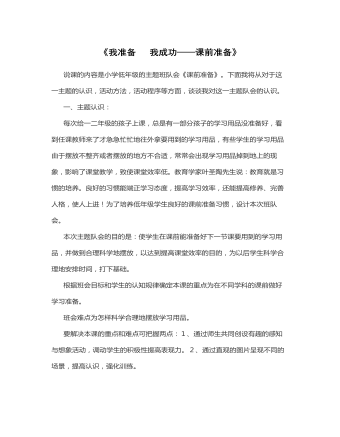
《我准备?我成功》说课稿
三、班会程序设计:为了每个孩子都能在视、听、说、做、思等行为过程中经历学习的过程,顺利达成学习目标,我设计的教学程序如下:1、引生入境,导入新课,激发兴趣。首先播放课堂上的同学们因准备不足,拿课本,拿笔,找本子垫,找练习本,文具盒掉到地上的录像。让学生通过观看录像让学生找到自己的影子谈谈自己的认识,认识到课前准备的重要性。抛出问题:怎样才能让我们的课堂避免类似事情的发生呢?以此引出课题。这种以影片为先导与创设情境相结合的导课方式,可以抓住学生的注意力,激发学生的好奇心,启发学生的想象力,使学生产生浓厚的兴趣。2、观察欣赏、拓展思维、突出重点。紧接着图片展示,观看不同场景的图片。(第一种是书桌上学习用品杂乱的,第二种是课桌上干干静静的,第三种是课桌上整齐地摆放着下一节课要用到的学习用品的。)在出示图片的过程中教师可以适当的解说。
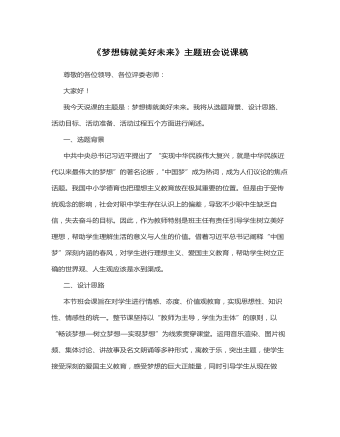
《梦想铸就美好未来》说课稿
第3步:提醒学生关注在实现梦想过程中遭遇困难与挫折时怎么办。这里我依然借助榜样的力量,邀请视频中的这位优秀毕业生走进课堂,请他谈谈在他成长、成功的道路上都遇到过什么样的困难,他是怎样解决的。可以让学生直接对他提问,与他对话。通过面对面的交流,学生能够近距离的真实的感受到成功就在身边,遇到困难时不能灰心丧气,更不能随意放弃,而应该充满自信,迎难而上,竭尽全力,克服困难。这一板块力图在前两个板块的基础上,帮助学生解决遇到的实际问题,即实现梦想的途径与方法,达到知、情、意、行的统一。整个环节我借助了切合学生实际的成功实例告诉学生,我们职校生通过自己的努力,不畏困难,从点滴做起,付诸行动,持之以恒,同样可以实现梦想,获得成功。
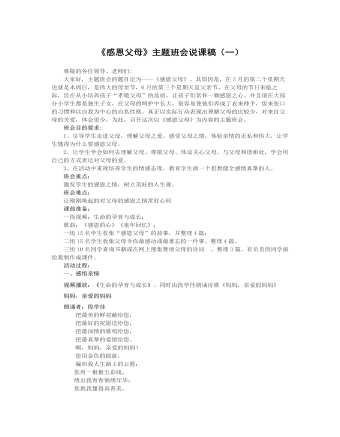
《感恩父母》说课稿(1)
通过观看视频和段学佳的诗朗诵,初步感悟母爱的伟大, 感悟身边亲情的无处不在。生命,是来自上天的赐予 。 在父母殷切的期盼中,茁壮成长。因而,生命承载了太多的目光和绵绵的情意。你听过这些故事吗?(结合课件演示) 由一组的四位同学汇报搜集的伟大母亲的故事和感恩的故事。有:《孟母三迁》中孟子的母亲为了使孩子拥有一个真正好的教育环境,煞费苦心,曾两迁三地;《地震中伟大母亲》她双膝跪着,整个上身向前匍匐着,双手扶着地支撑着身体,在她的身体下面躺着她熟睡的孩子,在母亲送给孩子的短信中这样写道“亲爱的宝贝,如果你能活着,一定要记住我爱你”。《羊羔跪乳》《乌鸦反哺》反映了动物母子间的亲情,启发学生就连动物都能懂得感恩父母,更何况我们人呢!通过这些感恩故事激发学生心灵上的感触。
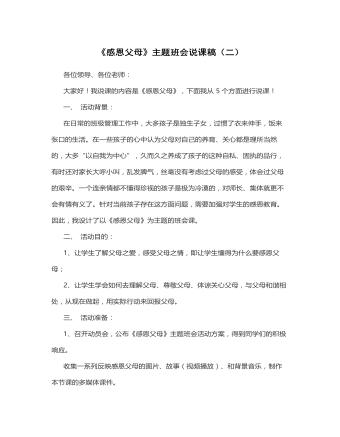
《感恩父母》说课稿 (2)
(你有邹越老师讲到的类似经历吗?请你结合自己的经历谈谈观看感受?)(展示视频重点,引发学生思考)78可怜天下父母心/儿行千里母担忧 /母行万里儿不愁这句话的含义教师启发引导(发动同学们讲自己的亲身故事,谈论观点,从他人的故事散发到自身,从而审视自我问题):讲完了这些故事,我的眼睛湿润了,此时此刻相信每一位同学的心情都无比的沉重,父母亲的爱在儿女面前是那么的无私而博大。设问你是不是一个有故事的人?请大家回想现实生活中父母为我们做过的,你为之动情的一两件事。(教师总结)如果说母爱是水,温柔而恬静,那父爱就是海洋,博大而深沉;现在,就让我们全体起立,用心去写孝道,我们宣誓,把心中对父母深深的感恩告诉他们,然后给我们的爸爸、妈妈一个深深的一鞠躬和最真诚的拥抱(配以音乐)
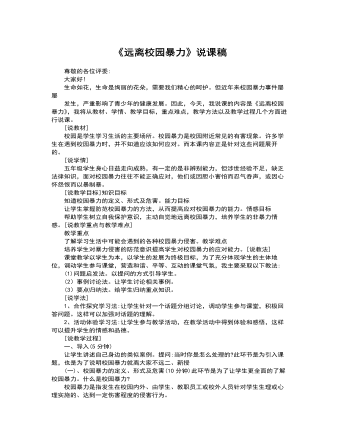
《远离校园暴力》说课稿
尊敬的各位评委:大家好!生命如花,生命是绚丽的花朵,需要我们精心的呵护。但近年来校园暴力事件屡屡发生,严重影响了青少年的健康发展。因此,今天,我说课的内容是《远离校园暴力》,我将从教材、学情、教学目标,重点难点,教学方法以及教学过程几个方面进行说课。[说教材]校园是学生学习生活的主要场所。校园暴力是校园附近常见的有害现象。许多学生在遇到校园暴力时,并不知道应该如何应对。而本课内容正是针对这些问题展开的。[说学情]五年级学生身心日益走向成熟,有一定的是非辨别能力,但涉世经验不足,缺乏法律知识,面对校园暴力往往不能正确应对,他们或因胆小害怕而忍气吞声,或因心怀怨恨而以暴制暴。[说教学目标]知识目标知道校园暴力的定义、形式及危害。能力目标让学生掌握防范校园暴力的方法,从而提高应对校园暴力的能力。情感目标帮助学生树立自我保护意识,主动自觉地远离校园暴力,培养学生的非暴力情感。
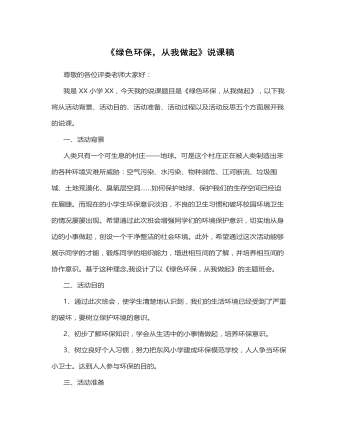
《绿色环保,从我做起》说课稿
在这个环节我根据会前学生搜集的资料并发挥其想象力、创造力让他们自编公益广告,如:“水是生命之源,请节约每一滴水。”“如果人类不节约水,那么最后一滴水将是人们的眼泪。”“让我们的空间更洁净,让我们的生活更美好!”“小草在生长,请不要打扰!”等等。【设计意图:这一环节培养学生的创造力和发散思维能力,用此种形式来进一步加深学生的环保意识。】6、宣读“绿色决心书”。(全体师生一同朗读)(1)随手关闭水龙头,节约水电,垃圾分类回收。(2)尽量少用塑料袋,少用一次性的纸杯、塑料杯(3)节约用纸,尽量少用餐巾纸,草稿纸尽量两面用(4)生活节俭,不随意浪费粮食,不剩饭,培养良好的生活习惯。(5)不乱扔垃圾,果皮纸屑,不随地吐痰,不随意采摘校园的一草一木,爱护公共绿地。(6)从我做起,号召全校同学树立环境意识,为创建绿色和谐校园出自己的一份力
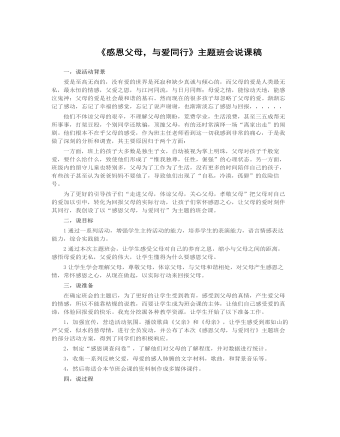
《感恩父母,与爱同行》说课稿
二,说目标1通过一系列活动,增强学生主持活动的能力,培养学生的表演能力,语言情感表达能力,综合实践能力。2通过本次主题班会,让学生感受父母对自己的养育之恩,缩小与父母之间的距离,感悟母爱的无私,父爱的伟大,让学生懂得为什么要感恩父母。3让学生学会理解父母,尊敬父母,体谅父母,与父母和谐相处,对父母产生感恩之情,常怀感恩之心,从现在做起,以实际行动来回报父母。三,说准备在确定班会的主题后,为了更好的让学生受到教育,感受到父母的真情,产生爱父母的情感,所以不能靠枯燥的说教,而要让学生成为班会课的主体,让他们自己感受爱的真谛,体验回报爱的快乐。我充分挖掘各种教学资源,让学生开始了以下准备工作。1,加强宣传,营造活动氛围。播放歌曲《父亲》和《母亲》,让学生感受到那如山的严父爱,似水的慈母情,进行全员发动,并公布了本次《感恩父母,与爱同行》主题班会的部分活动方案,得到了同学们的积极响应。
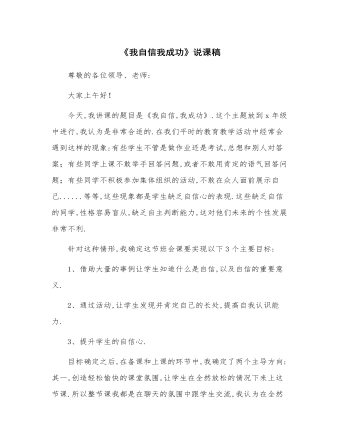
《我自信我成功》说课稿
在这个环节中,我首先让学生看了我给他们带来的故事:《握住自信》这个故事是主体明确而且比较典型的关于自信的正面事例.通过这个事例,首先给学生一个正确的引导.然后让学生讲讲自己搜集到的古今中外关于自信的故事,在学生搜集的故事中既有正面事例也有反面事例.在大量的事例中,在正反事例的对比中,学生谈自己听完故事之后的感受或想法,感受自信.接着,让学生讲了发生在自己身上的或周围人身上的关于自信的故事.这样,学生对自信的感悟以及与自信的距离就由远及近,让这些感悟不再遥不可及,而变得触手可及.在这个环节的最后,我给学生提供了一个视频故事《小鹰学飞》.在这个故事中小鹰学习飞翔,经历了多次失败,仍不放弃,在多次的努力后终于学会了飞翔.在这个故事的交流中,学生认识到要想成功,只有自信是不行的,还要学会面对失败,面对困难,那就是:面对失败,不气馁,不放弃,最终一定会取得成功.
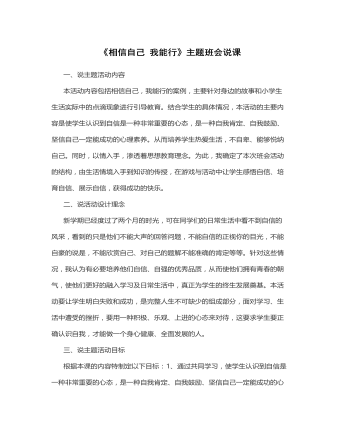
《相信自己?我能行》说课稿
师:原来是害怕失败,害怕老师、家长批评。其实,我们不可能每做一件事都成功,更不可能每次都是一次就成功。有句话说得好:“失败乃成功之母。”如果每个人都害怕失败而不敢去尝试的话,那么也就没有爱迪生发明灯丝所经历的1200多次失败和最后的成功了。所以,勇敢的去尝试吧,失败了不要紧,大不了从头再来,相信自己,你能行!师:接下来请大家欣赏一首非常好听的歌曲《相信自己》。(播放歌曲。)④培育自信小秘诀:师:听完歌曲,老师再传授大家几个培育自信的小秘诀:一是睁大眼睛,正视别人;二是昂首挺胸,快步行走;三是学会微笑;四是练习当众发言。⑤总结提炼。通过以上的活动,让学生说说对自信的理解,然后教师总结提炼小诗《我能行》:相信自己行,才会我能行。你在这点行,我在那点行。今天若不行,争取明天行。不但自己行,帮助别人行。相互支持行,合作大家行。争取全面行,创造才最行。相信自己,我能行!
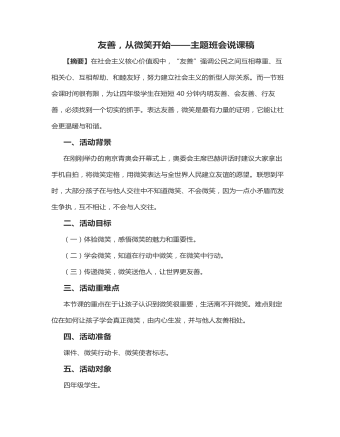
《友善,从微笑开始》说课稿
(二)我们学会微笑了解到“我们需要微笑”这一重点,班会课很自然进入下一版块,即“我们学会微笑”。这是本节课的难点所在,为了让孩子明白微笑只有由内心发出,伴有友好的行为,那才是友善,才是真微笑。我通过两个层次体现:体验活动室和视频直播间。1.体验活动室——学着微笑拿出镜子让孩子们面对镜子做一做微笑的表情,还可以请孩子到前面演一演,告诉孩子国际标准微笑要求,让孩子明白这只是表情式微笑。2.视频直播间——怎样微笑引入两段视频,一段是饭店服务员练习微笑,却总是笑不出来;一段是饭店服务员带着微笑热情地为顾客服务。让孩子讨论:第一段视频中为什么服务员练习微笑时笑不出来?第二段视频中服务员带着真诚的微笑热情为顾客做了什么?目的是让孩子知道真正的微笑是在行动中微笑,在微笑中行动,我们的世界因为微笑而美好。
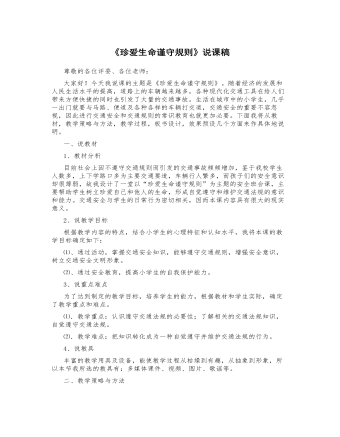
《珍爱生命谨守规则》说课稿
第二、遵守交通规则安全过马路魏书生说过,教师不替学生说学生自己能说的话,学生能讲明白的知识尽可能让学生讲。因此,我把学习时间充分还给孩子们。在这一环节中,老师先表演没有红绿灯的马路,让孩子们观察我是怎么做的,“一站二看三通过”,然后请学生,用“先……再……最后……”把我过马路的动作说出来。培养孩子们的观察和表达能力。再创设情境,让孩子们把课桌当作马路,跟我一起做一做。培养孩子们的生活实践能力和安全保护意识。接下来播放一段饶有趣味的视频:孙悟空与猪八戒过马路对话。采用这段视频,既符合学生的年龄特点,又紧紧围绕“交通安全教育”这一主题。看完视频后,学生说说视频中提到了哪些应遵守的交通规则?这样一来,学生们兴趣盎然,主动认知发现,巩固了对交通安全的认识,避免了直接讲授的无趣局面出现。
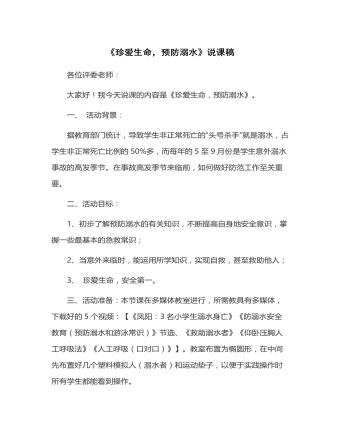
《珍爱生命 预防溺水》说课稿
随后设第二个问题:除了教材和视频里注意的内容之外,请问同学们还知道哪些防溺水安全的常识?这样学生之间会相互交流、各抒己见,课堂气氛活跃,使学生知道更多的安全常识,教师在加以总结、归纳(游泳“十六忌”)等。第二步,告诉学生,做好了第一步,万一还是溺水了,抛出第三个问题:该如何自救和救助他人呢?让学生相互讨论。然后教师针对不同对象进行分析、全面总结,并播放2个简短视频(节选《防溺水安全教育(预防溺水和游泳常识)》的内容和《救助溺水者》)让学生熟知怎样自救及岸上救人和水下救人,视频内容非常好,有针对性,讲解清楚,学生一看就能明白。设计意图:让学生在紧急时学会冷静思考问题,善于观察的能力,临危不乱的应变能力(图)第三步,实践操作阶段,讲溺水者被救上岸后,设第四个问题:如何紧急急救,有几种人工呼吸方法,具体怎样操作?这是本节课的难点。是通过播放视频《人工呼吸(口对口)》《仰卧压胸法》
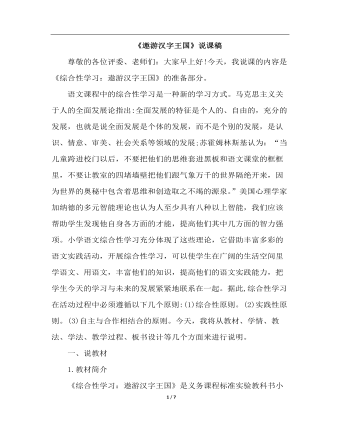
综合性学习:遨游汉字王国(说课稿)
一、说教材1.教材简介《综合性学习:遨游汉字王国》是义务课程标准实验教科书小学语文四年级上册第五组安排的一种学习形式。“遨游汉字王国”是由“汉字真有趣”和“我爱你,汉字”两个板块组成。“汉字真有趣”分别从字谜、有趣的谐音、汉字小笑话、汉字的起源等方面揭示了汉字的神奇性和趣味性。“我爱你,汉字”分别从汉字的演变、错别字的危害、汉字的书法艺术、汉字的魅力等方面,让学生了解中华汉字的灿烂文化。2.教学目标综合性学习是新课标对学生综合实践性学习活动重视的具体体现。它相对于学生来说是一种新的教学形式。通过本组的学习,学生可以了解到汉字历史的悠久,知道汉字记录并承载着中华的文明;同时还让学生清楚地看到汉字在今天同样具有强大的生命力,明白汉语如今在世界上影响的逐步扩大,从而激发学生学习汉字的兴趣和对祖国语言文字的热爱。根据本组教学的要求,结合实践活动的特点,联系学生的实际,我在摸索中制定了第一课时的教学目标:a、让学生感受汉字的音美、形美、意美。b、激发起学生探究汉字的欲望。c、让学生能根据兴趣爱好科学合理分组、分工,并能顺利开展活动。3.教学重点:让学生感受汉字的奇、趣、美,激发起学生的探知欲。
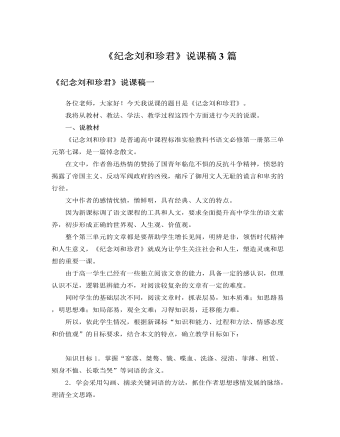
人教版高中语文必修1《纪念刘和珍君》说课稿3篇
1.说教材《记念刘和珍君》是鲁迅先生用饱醮着热泪,用悲愤的笔调写下的一篇感人至深的散文,既有对爱国青年沉痛的悼念,又有对反动派愤怒的控诉,也有对觉醒的国民的呐喊。《记念刘和珍君》是高中语文必修1第三单元第一课的讲读课文。文中描摹人物的音容笑貌,叙述人物的行为事迹,都融入了作者真挚的情感和深刻的感悟。对学生明辨是非,领悟时代精神和人生意义,有着重要的作用。新课标强调了要全面提升高中学生的语文素养,初步形成正确的世界观、人生观、价值观,并学会收集、判断、处理信息,具有人文素养、创新精神与实践能力。同时,《记念刘和珍君》感情真挚,感悟深刻,具有典型人文性。结合本单元教学目标,确立教学目标如下。
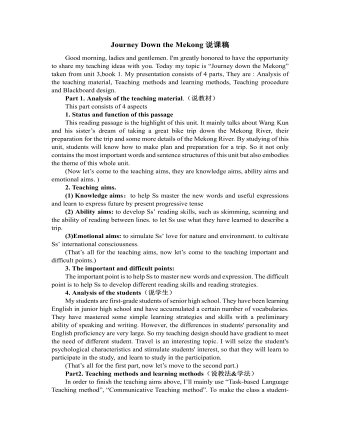
人教版高中英语必修1Journey Down the Mekong说课稿
2. let the Ss complete the forms paragraph by paragraph. Purpose here is to help Ss to get the habit of reading a passage as a whole, and pay attention to the organization of the text, as a result the Ss will fully understand the whole passage.3. ask Ss to retell the passage with the help of the key words in the form.Since the Ss in the class are in different levels, so I let them to fill in the blank to understand the meaning of the words and phrases better. ( That’s all for the while-reading. Now let’s move to the fifth step.)Step V: Post-reading (10mins) ---DiscussionIn this part students are asked to discuss in groups and list Wang Kun’s and Wang Wei’s attitudes about the trip. After that, Ss are encouraged to express their attitudes with the whole class. Collect their answers and don’t forget to praise them even if their answers may not be perfect.In this activity, discussion provides a vivid and active learning environment for Ss to communicate in English with newly learned language items. (Finally it comes to the homework.)StepⅥ: Homework (1min)1. Ss are required to read the text again after class and figure out the meaning of some complex sentences.2. Do the exercises on P19; This can help Ss to consolidate what they’ve learnt and make preparation for the next lessonPart4. Blackboard design.(说板书设计)On the top, there is the title of this lesson. On the left, there are main ideas for each paragraph. On the right, there are some new words and expressions.Unit 3 Travel journalJourney down the MekongMain idea of each para.:Para1: deciding to take a great bike trip along the Mekong river.Para2: Different attitudes between Wang kun and Wang wei.
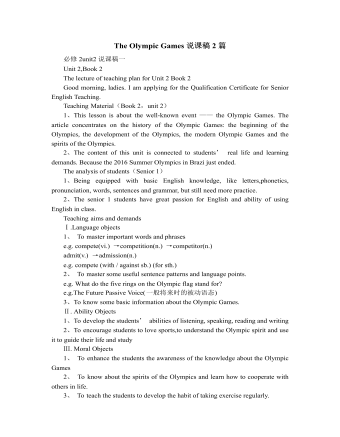
人教版高中英语必修2The Olympic Games说课稿2篇
Purpose of my design:To ask the students to do these two tasks will make the Ss predict the story of this passage. As a result, it will deepen Ss’ memory of this story because they will have their own understanding of this story.Step 3. While-readingTask 1. (Individual work _____min)Skimming: ask students to skim the text and the main ideas of each paragraph in this passage. Please read it quickly and then match the sentences with the letters.Task 2. (Individual work _____min)Scanning: read the text quickly and decide the whether the following statements are true or false and give reasons.Task 3. (Pair work _____min)Listen to the tape and fill in the banks. Then read the paragraph with expression to your partner.Task4 (individual work min)Listen to the tape again and write down the main idea in one sentence.Purpose of my design: Enable students to understand the given material better by using different reading skills. And proper competition can arouse the Ss’ interest in English learning. “Task-based” teaching method is used here todevelop the Ss’ ability of communication and also their ability of co-operation will be well trainedStep 4. Post-readingTask 1. (Individual work, pair work, group work, class work; _____min)Discussion (group of 4):1. If you were Hippomenes, would you run against Atlanta?2. Do you think Hippomenes deserved to win the race? Why or why not?Step 5. HomeworkPlease read the story again carefully after class and imagine: What will happen during the race between Hippomenes and Atlanta? Who do you think will win the race? Do you think Atlanta would marry Hippomenes? Write an end for the story with thses questions.Purpose of my design: Homework is so important and necessary for to master the knowledge they learned after class. It will check whether the Ss achieve the teaching aims.Part 5 Blackboard design
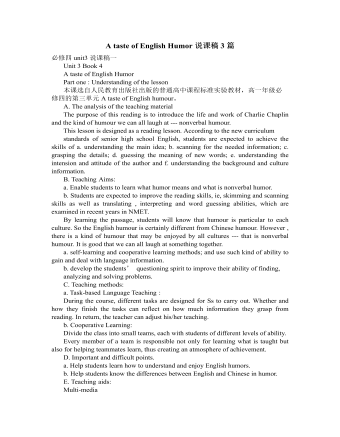
人教版高中英语必修4A taste of English Humor说课稿3篇
Then I would ask them to think of a funny English or Chinese and tell it to partners. While telling stories, they can use expressions and some acting to help make the story funny. 5 minutes would be given to do this.Those stories they told there will be the material for their writing. Soletting them tell it at first is helpful. And they can make a difference between telling a funny story and writing it down. Generally speaking, it is difficult forstudents to write well because they don’t know what to write and how to write. Asking them to tell their own stories at first can help them come up with what to write.After their telling, I would invite someone to share his/her story with all of us and I would write it down on the blackboard.This example story would be used as a sample to illustrate the format of funny story. Different from a story from teacher or textbook, a story from students can obviously become a interesting material to draw students’ attention.Then I would ask the whole class to put this story into several parts. It might be a little bit difficult for them. So I would ask them to find out whether all the sentences are necessary. After delete some sentences, there are 6 sentences left behind. Then they can easily put them into three parts. After interaction with students, I would teach them the right terms for each part and conclude the format of funny story.This step is the key and difficult point in my lesson. So I mainly usetask-based teaching method in this part and the task for students was divided into several stages. With the separated difficult level, students can find there are usually three parts in writing. They can also learn to write without the unnecessary parts in the process of analyzing. And then I wouldn’t rush to tell them the right terms to them directly. Instead, I would ask them to name them by their own. A confused mind is better for acquiring knowledge.While-writing:Then I would give students 7 minutes to write down this story, without other requirements.With all the preparations in pre-writing, students’ difficulties were cleared. So it would be much easier for them to write down the story within 7 minutes. There are no other requirements because students’ first writing is actually a drafting. It would be revise and edit several times later. Writing, as a skill
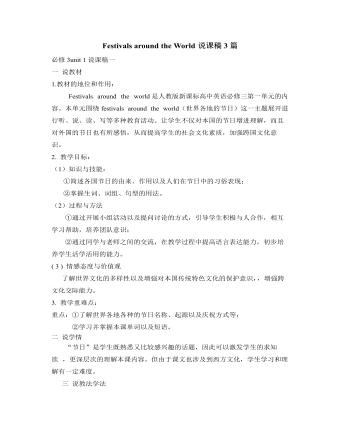
人教版高中英语必修3Festivals around the World说课稿3篇
Teaching plan for Unit 1 book3Good morning, teachers. It’s my great pleasure to be here because I can share my lesson with you and I can learn a lot from it. I’ll begin my lesson from the following four parts, the teaching material, the teaching methods, the studying methods and the teaching procedure.Firstly, let me talk about the teaching material. The content of my lesson is the reading passage festivals and celebrations of Unit 1 Festivals around the world. This passage is about festivals and celebrations. By studying this passage, we’ll enable the students to know that festivals exit everywhere, and many of festivals in different countries celebrate similar ideas. As we all know, the reading passage is the center of each unit. If the Ss can learn it well, it will be helpful to make the Ss learn the rest of this unit.After studying the teaching material, I think the teaching aims are as the followings:1. Knowledge aims:(1) The Ss can master the usage of the important words andexpressions.(2)The Ss can use the __________________ (grammar) in the proper situation.Make students know about the festivals all over the world and the detail of the festivals, such as origin, content, and the date of the holiday festivals.2. Ability aims:(1) Students can talk about festivals and celebrations in English(2) To improve the student’s reading ability, especially their skimming and scanning ability.3. Emotion aims:Make the Ss know about the foreign festivals, and respect other countries’ custom.Next, let’s come to the important points and the difficult points.The important point is how to make the Ss understand the text better and the difficult point is how can they talk about it. secondly, Teaching Methods:1. task-based Language Teaching2. Computer assisted language teaching.3. question-and–answer methodThirdly, Studying Methods:
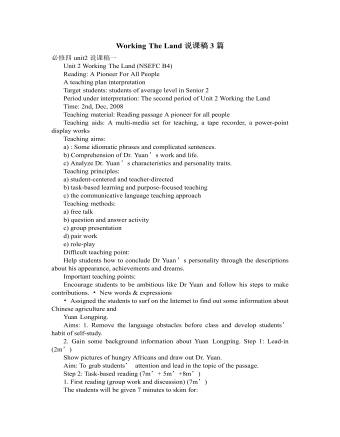
人教版高中英语必修4Working The Land说课稿3篇
Knowledge objectives:(1) to make Ss grasp the usage of words, expressions and sentence structures: statistics, struggle, thanks to, rid of, some patterns for persuasion, the “ing” form as subject and object;(2)to use learnt knowledge to persuade sb.Ability objectives:(1) to develop Ss’ reading skills(skimming, scanning, word guessing);(2) to improve Ss’ speaking, communicating and cooperating skills.Emotional objectives:to make Ss know the contribution of Yuan,and learn his spirit and his simple life time.Teaching important and difficult points:(1) some words, expressions and sentence structures mentioned above;(2)the content of the text;(3)training their reading and speaking skills.Teaching methods: CLT, TBLT,QT.Learning strategies: CLS, QLS, TBLS.Teaching procedures:Step 1 lead-in: (1) teacher plays a piece of recent news from CCTV about the harvest of the super hybrid rice, and ask students whether they know Yuan or not, and talk about him and his contribution.(2)Brain storm: let Ss describe Yuan in their minds including his appearance, his living condition and so on.Step 2 fast reading tasks:(1)teacher introduces Yuan and super hybrid rice(2)make Ss read the text as fast as possible with questions. Such as: what’s the general ideaof this passage? What’s Yuan’ dream? (skimming and scanning skill)Step 3 intensive reading tasks(1)let Ss read the text silently, find topic sentence of each paragraph and draw the difficult sentences and the knowledge what they don’t understand.(words guessing)(2)teacher and Ss talk about the important words, expressions and sentences together, and ask Ss to retell the content of the text.(summarizing and paraphrasing)(3)teacher summarize this part.(4) read again following the courseware.
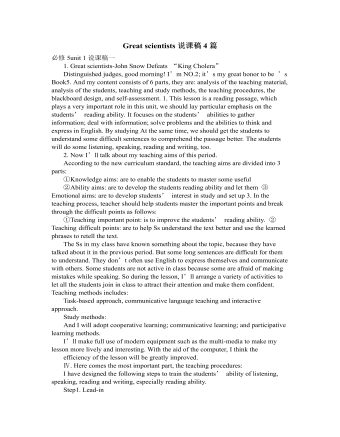
人教版高中英语必修5Great scientists说课稿4篇
通过写文章梗概,培养学生综合运用语言的能力,学习用恰当的英语描述科学家的故事。这是本课的教学难点。教师可以使用完形填空的方式来帮助学生整理语篇,从而来降低难度。本课的教学重点的突破方法是:在阅读前,让学生初步了解得出科学观点所需要的基本程序,从而轻松而自然地导入文章的阅读;在阅读过程中,由易到难设计快速阅读和精读的问题,层层推进各种阅读活动,让学生对阅读内容从整体感知到细节理解,最后深层读懂整篇文章,同时加强阅读策略的指导,让每个学生都主动参与课堂教学活动,最终达到提高阅读能力的目的。Step 4 Post-readingGroup Activities四人小组共同合作,在老师的适当指导下,就以下2个问题展开讨论,让学生就所知、所学、所感和所想融入话题,然后抽若干同学代表作小组发言。1. What do you think about John Snow, and what should we learn from him?2. Cholera was 19th century disease, which two diseases are similar to cholera today? Why?

